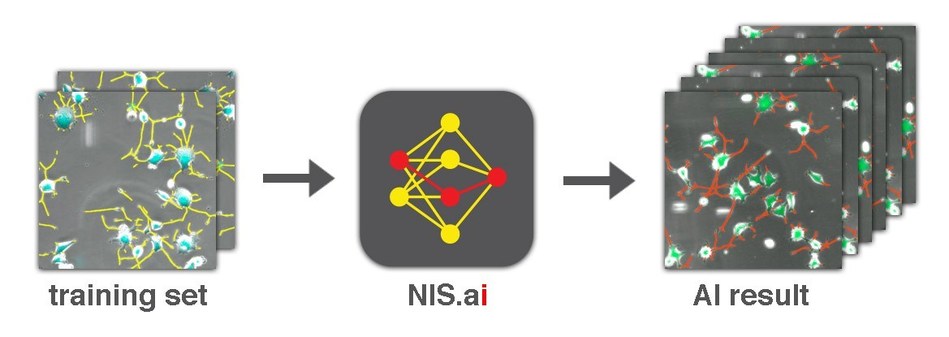Nikon Announces Artificial Intelligence (AI) for Predictive Imaging, Image Segmentation and Processing
NIS.ai Enables Researchers to Easily and Accurately Extract Unbiased Data from Vast Amounts of Datasets
Nikon Instruments Inc., innovator of advanced microscope systems, announced NIS.ai, a powerful image analysis and processing module for NIS-Elements that leverages Deep Learning and Artificial Intelligence. NIS.ai is a suite of new AI-based processing tools that utilizes convolutional neural networks to learn from small training datasets supplied by the user. The training results can then be easily applied to process and analyze huge volumes of data, enabling researchers to increase throughput and expand their application limits.

NIS.ai includes a suite of applications for predictive imaging, image segmentation and processing:
- Convert.ai: Convert.ai learns related patterns present in two different imaging channels. After training, Convert.ai can then predict the pattern in the second channel even when presented with only the first channel. DAPI-based staining of nuclei is a common method for cell segmentation and counting. Convert.ai can be trained to predict where the DAPI label would be based on unstained DIC or phase-contrast images. This enables users to perform nuclei-based image analysis without ever having to stain samples with DAPI or acquire a fluorescent channel.
Read More: AiThority Interview with Pedro Arellano, VP of Product Marketing at Looker
- Segment.ai: Segment.ai enables complex structures to be easily identified and segmented. Neurites in phase-contrast images are traditionally difficult to define by classic thresholding. Segment.ai can be trained on a small subset of hand-traced neurites to automatically detect and segment neurites from thousands of untraced datasets.
- Enhance.ai: Imaging dim fluorescent samples or applications that require low-level light exposure typically result in compromised image quality with poor signal-to-noise ratio. Enhance.ai learns what a high signal-to-noise image looks like by comparing under-exposed and optimally-exposed images. Enhance.ai can then restore details in under-exposed or dim fluorescent images, enabling researchers to gain more insights from their low-signal imaging applications.
- Denoise.ai: Launched earlier this year, Denoise.ai removes shot noise from resonant confocal images and can be performed in real-time. Applying Denoise.ai to resonant confocal imaging enables users to acquire confocal images at ultra-high speed without sacrificing image quality.
Read More: World’s Largest Blockchain Application Competition ‘Klaytn Horizon’ Winners Announced
“The application of Deep Learning and AI to biomedical imaging is extremely powerful, and opening up unseen possibilities,” said Steve Ross, Ph.D., Director, Products & Marketing, Nikon Instruments Inc. “With NIS.ai, researchers can easily apply deep learning to extract meaningful, unbiased data from large, complex datasets.”
Read More: Penta Security and R3 Announce Strategic Partnership for Digital Asset Management and MPC Technology







